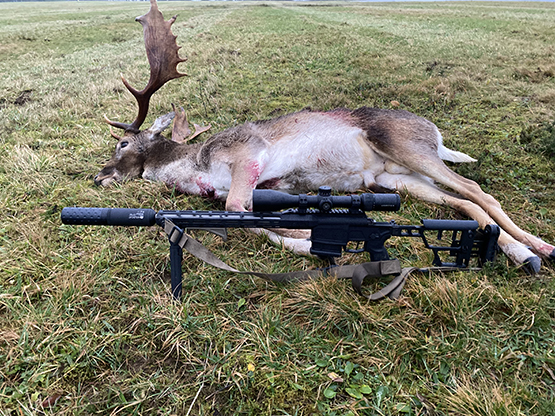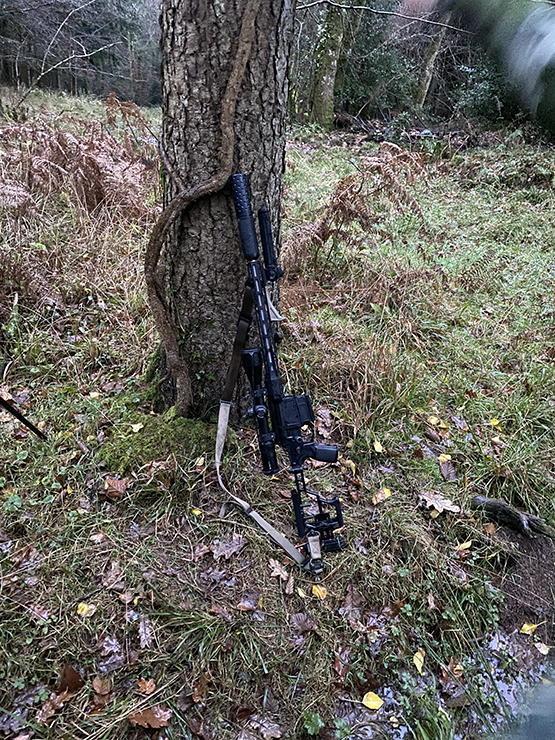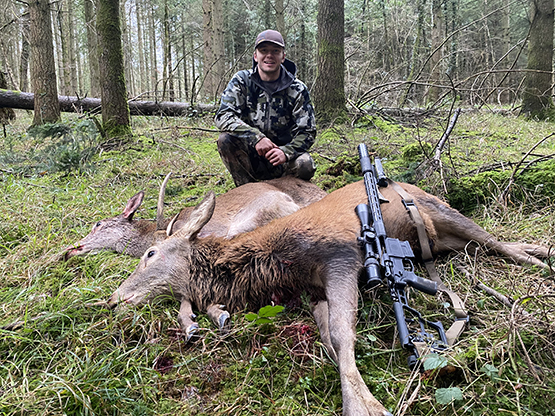British Army Officer Ollie Ward reviews the unconventional Sig Sauer Cross rifle and considers its suitability for hunting.

The Sig Sauer Cross is about the most unconventional hunting rifle that exists. Made from aluminium it has a full-length M-Lok rail over a free floated stainless-steel barrel. Behind this sits a receiver that accepts AICS pattern magazines, with an ambidextrous AR-style safety and pistol grip. On the back of the rifle sits a folding, skeletonised stock, which in my opinion, is the pièce de résistance of the Cross, but more on that later…
I dislike most chassis rifles for hunting in the same way that I would dislike a V4 engine in a Mustang. They are heavy, cumbersome, and unwieldy, making a day in the hills an absolute chore. Despite their eye-catching looks, seldom do they provide enough bang to match the buck. After all, ounces make pounds, and pounds make pain. All too often, chassis rifles are an attempt to upgrade average actions into a precision tool, but for stalking, any tangible benefits are offset by the sacrifices in weight.
Although the Cross looks like a chassis rifle from a distance, it isn’t. It is built on a monolithic action which provides both a solid mounting platform, and gives it a high quality, rigid feel in the hands. Unlike many all-metal skeletonised rifles, which tend to be exceptionally heavy due to their design for precision rifle competition, the Cross is exceptionally light, tipping the scales at just 3kg naked.
Sig claim that the Cross was “conceived to fit the needs of modern hunters”. Well, what are those needs exactly? To me, it boils down to seven subjects: accuracy, handling, versatility, adjustability, reliability, lethality, and most importantly… looks.

Accuracy. The Cross has a medium profile stainless steel barrel with a 1:8 twist. The standard twist rate for 6.5 Creedmoor rifles. The rail surrounding the barrel allows it to be free floated and doesn’t interfere with barrel harmonics. It does exceptionally well at stabilising everything up to 150gr projectiles. The next figures were shot without allowing the barrel to cool between groups and the results were impressive. With Hornady ELDX 143gr my average 5 shot group was 0.72moa. With Sako Blade 120gr my average five shot group was 0.84moa. This rifle certainly seems to prefer heavier bullets, however the Sako Blade grouping is certainly nothing to sniff at. It is an absolute tack driver and undoubtedly a rifle that can outshoot me.
Handling. The short 18-inch barrel (16 inches on the .308 model) certainly makes this rifle easy to move with. Even with a suppressor in place (I use a Wildcat Evolution) it doesn’t feel too long, though perhaps a little front heavy. I’ve installed a Magpul Angled Foregrip, which has negated most of this imbalance allowing me to pull the rifle into the shoulder with a C-clamp grip.
The full-length M-Lok rail which surrounds the barrel is slender and allows a comfortable C-clamp or traditional grip. It is lightweight and comfortable to hold. I get on well with the AR-style pistol grip, the ambidextrous safety allowing both wrap-around and thumb rest grips for those longer shots.
The bolt has a 90 degree throw and three locking lugs. In my experience it runs smooth like butter, locks up tight, and can take an absolute beating. I have run this bolt relentlessly and it has taken everything I have thrown at it. It can be put into battery slowly, preventing spooking deer when making your rifle ready in your high seat. However, if you run the action slowly in reverse it can often fail to extract.
The folding stock is a nice touch and neatly locks into the side of the rifle whilst also securing the bolt for transit. With the suppressor removed and stock folded, I can comfortably fit the Cross inside a hiking backpack - allowing discreet transport and walks to stalking sites. The buttstock is comfortable and absorbs much of the (albeit minimal) recoil from the 6.5 Creedmoor round. I have found shooting from sticks to be more difficult than with a conventional stock due to the minimal width of the skeleton stock on the Cross. I have only used one brand of quad sticks, however, so will likely have to trial some different brands.
All in, with a scope and moderator, my Cross comes in at 4.1kg - the same as a completely naked Blaser R8 Ultimate. Make no mistake, this is an absolute featherweight rifle, and one that is nothing short of a joy to carry.
Versatility. The Cross accepts AICS pattern magazine, meaning you can run it as a 12+1 if you’re so inclined.
“Why the hell would I need a 12-shot magazine for stalking?” I hear you ask. Keep in mind though that this rifle isn’t marketed for deer alone. In some states in the US, where wild pigs are rife and the hunting guidelines are ‘take as many as you can, however you can’ this may not be out of the realm of possibility. Similarly, for the professional deer manager, this additional capacity could be extremely useful when carrying out a large cull. However, I usually opt for the 5-round magazine for stalking which the Cross comes with as standard. The magazine release mechanism for the Cross is a small button on the inside front of the trigger guard. This can be actuated with either the shooting or support hands. I love the location; it is almost impossible to drop the magazine unintentionally.
The stainless-steel barrel is surrounded by a full-length M Lok rail which allows for attachment of a multitude of accessories: bipods and grips in the 6 o’clock position; torches for lamping at 3 and 9 and thermal add-on scopes or Infrared lasers at 12 (the latter potentially useful for pigs at night coupled with a night vision monocular). This may all seem a bit too futuristic and militaristic, however these methods (especially with our friends across the pond) are becoming increasingly viable options for the harvesting of game.

Above: Ollie Ward enjoys some success on the Red's during a recent Capreolus Club trip
Adjustability. As teased earlier, the skeletonised stock on the Sig Cross is without a doubt the best feature on this rifle and is entirely hand adjustable. For comb height, simply unlock the spring-loaded comb and adopt your shooting position. Once you have a perfect sight picture simply lock it up. The length of pull adjustment is equally as simple. One wingnut unlocks the butt pad and locks it in place securely. I had concerns that these hand adjusted parts would be fragile, but these worries were quickly proven to be unfounded. The trigger on the Cross is a two-stage, and adjustable from 2.5lb – 4lb: I prefer these over single stage triggers. They allow me to take up the slack before I release the shot and feel familiar as someone who spends much of his professional career behind a service rifle. Both these features allow the Cross to be ‘fitted’ to the shooter, allowing a comfortable shooting position, quicker target acquisition and increased accuracy.
Reliability. The ejection port is high on the side of the action and is diminutive in its appearance. The small size reduces the chance of debris getting inside the action and
inducing a stoppage, but perhaps could increase the chance of a failure to extract, however the extractor has some oomph and throws shell casings out of the port with a satisfying amount of gusto. I have run this action as fast as humanly possible and never once has the bolt failed to extract or pick up a round into battery. I have used a variety of different magazines but have settled for both the 5 and 10 round Magpul P-Mags. I prefer polymer magazines over steel (sacrilege I know) because of steel’s tendency to bend and rust. Bending is particularly common on the feed lips and rust on the magazine can transfer into the working parts of the rifle. I have run close to 300 rounds through the Cross without a light primer strike or stoppage. Once I have a higher round count, I will update this article. Thus far it certainly seems to be a very reliable rifle.
Lethality. The short 18-inch barrel results in a reduction in muzzle velocity, roughly 121ft/sec at the muzzle when compared to a 24-inch barrel (depending on load). For most hunting across the UK, where shots are usually no more than 200 yards, and the biggest animal we’re likely to tackle is a big lowland Red, the reduced velocity is not particularly an issue. However, one should consider the prospect of not making ethical hits on distant or larger game (Moose, Elk and Brown Bear) particularly when using this rifle over in the US or Europe. For these tasks, I would prefer a calibre which has a bit more bite: think 30-06 or 300 Win mag! Having said that, I am a staunch advocate of the idea that placement beats power. History has shown that many hunters have been very successful in harvesting all three of the aforementioned species with 6.5 Creedmoor and similar calibres. All it takes is correct bullet placement.
Without adequate velocity your rounds aren’t going to expand reliably and thus create a wound channel tolerable for putting an animal down dependably. I need to do some more experimentation with different loads to figure out which grain weight I prefer. The toss up for me is between a heavier round with a larger payload or a lighter round with increased velocity. Stand by for those results in the future.
Aesthetics. It would be remiss of me to pretend that aesthetics has no bearing on choice of firearm. If that were the case, blued steel, high-grade wood, and artistic engraving would all be consigned to the past. The Cross is strictly business; however, the precise machining, durable finish and angular styling certainly gets me a little hot under the collar. It’s a looker.
Closing thoughts
The Cross and its contemporaries are certain to ruffle a few feathers within the stalking community, but I for one love both the way it looks and its capacity as a hunting tool. We as a community are all too quick to accept and welcome innovations in other areas of our equipment. Yet, I doubt many hunters now would be willing to trade their: Gortex, Optics and Carbon fibre rifles, for: wool, iron sights and wood. So why is this style of rifle vilified by so many?
I believe some of this stems from noble intentions. We, as a community, have a PR problem and it is easy to see why the Cross looks scarier to non-hunters than a wood stocked, glass bedded rifle with the same capabilities. Discouraging hunters from taking ‘scary’ looking rifles into the woods, to promote a better relationship with the general public, is an admirable stance, however I would argue that education and inoculation is a better tool. Do we want to hide contemporary hunters away and stagnate innovation within the British hunting community? I think not.
It may not be as slick as your regular Blaser or Sauer, but for the money I am a fervent believer that this is perhaps the most innovative and functional hunting rifle on the market. With some decent glass on top, this rifle will outshoot 99% of the community (I know it has certainly done so to me). In short, it is light, accurate, lethal and a pleasure to shoot.
Oliver Ward is currently serving as an Infantry Officer in the British Army. He has been a member of the deer stalking club - Capreolus Club for three years and has an avid interest in precision rifle shooting and firearms as well as hunting.
To read other rifle reviews follow this link: rifle-reviews
To follow Ollie on Instagram: Olliewardhunting
If you’d like to start deer stalking but don’t know where to get started then visit the Shooting & Hunting Academy where you can find the Proficient Deer Stalking Certificate Level 1 PDS1, it’s the perfect place to get started. Proficient Deer Stalking Course - PDS1



















